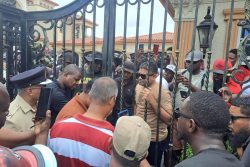In its 2022 Labour Review, published at the beginning of February this year, the Inter-national Labour Organisation (ILO) revealed that the average unemployment rate for Latin America and the Caribbean (the region in which Guyana falls) was 7.2 percent. This places it at below the pre-COVID level of 8 percent in 2019.
When compared to the global economy, the ILO report said, Latin America and the Carib-bean’s performance in 2022 was “relatively good”. It added, “The economies of Latin Ameri-ca and the Caribbean continued on the recovery path which began in 2021, as the effects of the health emergency linked to the COVID-19 pandemic were being left behind.”
That was the good news. On the flip side, the ILO found that taken altogether, inflation in the region topped 8 percent (some individual countries had higher rates), but minimum wages had not kept pace. In fact, in many instances, the real value of the minimum wage was lower than before the pandemic.
Framers of the ILO report also noted that not all of the countries in the region had the same level of success with job creation and in 10 of them the unemployment rate only fell in the last quarter of 2022. They saw it fit to express concern that, based on the trends they were observing, the 2023 labour market was going to be both “highly complex and uncertain”.
More than that, the data revealed that between 40 and 80 percent of the jobs created fell into the category of informal occupation. This refers to those employees who usually receive no benefits like national insurance, health insurance or paid time off, for example. Further, their incomes tend to be low – at, or below, the minimum; and they have no union protection, which means they could be fired arbitrarily, a situation which lends to a great deal of instability or job insecurity. This is easily summed up in a single word: exploitation. These informal workers, the ILO estimated, make up between 70 and 90 percent of the working poor.
Some economists and academics define the working poor, in layman’s terms, as people who are in regular employment – a 40-hour work week for 50 or 52 weeks per year – but are unable to meet basic expenses owing to poor wages. In local parlance, they would be described as those who are “barely able to keep their heads above water”. They live pay cheque to pay cheque, but are not to be confused with that other subcategory: those who live above their means and for that reason are unable to pay their bills.
In Guyana, very often that informal job as general dogsbody, shop clerk, factory worker, school sweeper or security guard is all that stands between the working poor and utter penury. They are not so poverty stricken as to be called destitute, yet their situation is probably just as miserable. They could work at that unskilled job for years, but never be able to improve their circumstances. Not because they are not experts at penny-pinching, but because personal contingencies and global reverberations perpetually conspire against them.
Those who choose to pursue small-scale entrepreneurship usually find that they are not that much better off. A flood or any natural disaster, a global pandemic, or a fire (note the effects of the Parika Market fire on vendors) could very easily find them falling off the ledge with very little or no cushion to help them bounce back.
While the term might be unfamiliar, the working poor are not. Some of them guard our workplaces, they assist us in the store, or bag our goods at the supermarket. Many of us might have shopped alongside them at the market. It is also probable that we might have employed them to clean our houses and yards, or even been among their ranks at some point – as a few do manage to escape.
In the local context, education and migration are two of the major routes by which this infernal cycle has been broken over the years, but only on an individual basis. Unfortunately, however, the numbers of working poor have been increasing rather than reducing, which points to burgeoning imbalances in spite of, or owing to, the country’s much touted oil prosperity. Anything less than determined efforts to address this could ultimately result in a domino effect and lead to further deterioration of society.
The measures that can be taken by government are all well known and include paying living wages, subsidised housing (which is not the same as offering people who have lived in the city all their lives, a low-income house in the back of beyond without roads, potable water or electricity), and lowering taxation against this target group. Streamlined welfare services, rather than one-off handouts, would also be extremely helpful. Along with the uniform grant already in place, these could stretch to means-tested food stamps or vouchers so that parents do not have to stress over whether to feed their children or pay their bills.
The maxim that when one falls we all fall does not seem to have penetrated the mist through which those who live in privilege at the taxpayer’s expense view the world. The working poor are, unfortunately, the least visible. The assumption is that they are able to eat by the sweat of their brows. The reality is that too many of them are sinking; this newspaper’s current ‘Cost of Living’ series is evidence of that. They need a lifeline.








